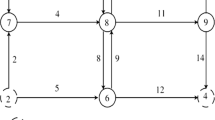Abstract
Here is a multi-criteria approach to identify and evaluate network-flow monitoring strategies in a stochastic environment. We propose an analytical approach for assessing flow disturbance, based on limited sampling of arc-flow information in multi commodity, or multiple origin-destination (O–D), networks. A disturbance is defined here as abnormal network traffic beyond routine fluctuations. The network is characterized by arcs that are available with certain probabilities, suggesting a busy packet-switching/circuit-switching network, or simply network with failing components. Given the huge state space of such stochastic networks, our first objective is to bound the expected flow for computational efficiency. This is accomplished by extending available single-commodity-network results to the multi commodity case. The second objective is to determine the best placement of flow monitors to obtain the most accurate estimates of traffic flow, as represented by O–D pair traffic volumes in order to detect a disturbance. We followed a multi-criteria approach in defining and evaluating all possible monitor-placement strategies satisfying monitor availability. To assess a traffic pattern, O–D volumes are estimated using the l p -metric for p = 1, 2 and ∞, representing a decision-maker's risk-preference structure. The final objective is to define a disturbance metric providing confident assessments on the occurrence of a flow disturbance. In this regard, we use linear-regression to generate confidence intervals around the expected flow for each O–D pair. This is supplemented by the Fisher Method of Randomization, a non-parametric test, for small networks. Unlike the Fisher-test results, it appears the linear-regression “disturbance metric” is very sensitive to detecting “disturbance.” Preliminary results suggest that among the three l p metrics in O–D estimation, it appears that the best is the l2-metric, which provides the appropriate sensitivity and accuracy. Counter to intuition, it is also observed that the “disturbance” estimation error generally decreases as the number of sampled arcs decreases.
Similar content being viewed by others
References
Y.P. Aneja and K.P.K. Nair, Multi commodity network flows with probabilistic losses, Management Science 28 (1982) 1080–1086.
C. Antoniou, M. Ben-Akiva and H.N. Koutsopoulos, Incorporating automated vehicle identification data into origin-destination estimation, Transportation Research Record 1882 (2004) 37–44.
T.G. Bailey, Response surface analysis of stochastic network performance. MS Thesis. School of Engineering, Air Force Institute of Technology (1988) Wright-Patterson AFB, Ohio.
M. Ball, Complexity of network reliability computations. Networks, 10 (1980) 153–165.
M.S. Bazaraa, et al., Linear Programming and Network Flows, 2nd Edn. (Wiley, New York, New York, 1990).
O. Berman, R.C. Larson and N. Fouska, Optimal location of discretionary service facilities, Transportation Science 26(3) (1992) 201–211.
O. Berman, D. Bertsimas and R.C. Larson, Locating discretionary service facilities, II: maximizing market size, minimizing inconvenience, Operations Research 43(4) (1995) 623–632.
O. Berman, D. Krass and C.W. Xu, Locating discretionary service facilities based on probabilistic customer flows, Transportation Science 29(3) (1995) 276–290.
L. Bianco, G. Confessore and P. Reverberi, A network based model for traffic sensor location with implications on O/D matrix estimates, Transportation Science 35(1) (2001) 50–60.
J.V. Bradley, Distribution-Free Statistical Tests, (Prentice-Hall, Englewood Cliffs, NJ 1968).
A. Brooke, et al., GAMS: A User's Guide, The International bank for reconstruction and development/The World Bank (1988).
M. Carey and C. Hendrickson, Bounds on expected performance of networks with links subject to failure, Networks 14 (1984) 439–456.
Y. Chan and M.Y. Rahi, An l p -norm origin-destination estimation method that minimizes site-specific data requirements. Transportation Research Record 1413 (1993) 30–140.
Y. Chan, E. Regan and W. Pan, Inferring an origin-destination matrix directly from network flow sampling, Transportation Planning and Technology 11 (1986) 27–46.
Y. Chan, E. Yim and A. Marsh, Exact and approximate improvement to the throughput of a stochastic network, IEEE Transactions in Reliability 46(4) (1997) 473–486.
H.-Y Chang, On real time intrusion detection and source identification. PhD dissertation, North Carolina State University, (2000) Raleigh, North Carolina.
A. Chen, P. Chootinan and S. Pavinvongvuth, Multiobjective model for locating automatic vehicle identification readers. Transportation Research Record 1886 (2004) 49–58.
P. Chootinan, A. Chen and H.Yang, A Bi-objective traffic counting location problem for origin-destination trip table estimation, Transportmetrica 1(1) (2005) 65–80.
W.J. Conover, Practical Non-parametric Statistics, 2nd Edn., (Wiley, New York, New York 1980).
K.J. Cormican, D. Morton and K.R. Wood, Stochastic network interdiction, Operations Research 46(2) (1998) 184–197.
R. Evren, Interactive compromise programming, Journal of the Operational Research Society 38(2) (1987) 163–172.
C. Gedeon, M. Florian and T.G. Crainic, Determining origin-destination matrices and optimal multiproduct flows for freight transportation over multimodal networks, Transportation Research B 27B(5) (1993) 351–368.
D.P. Gerakoulis, A parameter for vulnerability evaluation of packet switched communication networks. IEEE Global Telecommunications Conference 2 (1991) 944–948.
F. Harary, Graph Theory (Addison-Wesley, Reading, Massachusetts 1972).
C.-C. Hsieh and Y.T. Chen, Resource allocation decisions under various demands and cost requirements in an unreliable flow network, Computers and Operations Research 32 (2005) 2771–2784
E. Israeli and R.K. Wood, Shortest-path network interdiction, Networks 40(2) (2002) 97–111.
H. Kalyoncu and B. Sankur, Estimation of survivability of communication networks, Electronic Letters 28(19) (1992) 1790–1791.
Y.-K. Lin and J. Yuan, Flow reliability of a probabilistic capacitated-flow network in multiple node pairs case, Computers and Industrial Engineering 45(3) (2003) 417–428.
D. Lyle, Y. Chan and E. Head, Improving information-network performance: Reliability versus invulnerability, IIE Transactions 31 (1999) 909–919.
M. Minoux, Network synthesis and optimum network design problems: Models, solution methods and applications, Networks 19 (1989) 315–317.
P.M. Murray-Tuite and H. Mahmassani, Methodology for determining vulnerable links in a transportation network. Transportation Research Record 1882 (2004) 88–96.
G.L. Nemhauser and L.A. Wolsey, Integer and Combinatorial Optimization (Wiley, New York, New York 1988).
J. Neter, et al., Applied Linear Statistical Models, 3rd Ed, (Irwin, Homewood, Illinois 1990).
L.M. Rasmussen, Zero-one programming with multiple criteria, European Journal of Operational Research 26 (1986) 83–95.
A. Robinson, Assessing the vulnerability of multi-commodity networks with failing components: MS Thesis Air Force Institute of Technology, Department of Operational Sciences, (1994) Wright-Patterson AFB, Ohio, (including Thesis Extension, which is obtainable via E-mail: ychan@alum.MIT.edu)
S. Ross, A First Course in Probability, 2nd Edn., (Macmillan, New York, New York, 1984).
G.T. Ross and R.M. Soland, A multicriteria approach to the location of public facilities, European Journal of Operational Research 4 (1980) 307–321.
M.H. Schneider and S. A. Zenios, A comparative study of algorithms for matrix balancing. Operations Research 38 (1990) 441–449.
L. Roshan Sharma, Network Topology Optimization. Van Nostrand Reinhold, New York, New York (1990).
R.D. Shier, Network Reliability and Algebraic Structures, Oxford University Press, (Oxford, United Kingdom. Stathopoulos 1991).
A. Stathopoulos, T. Tsekeris, Enhanced dynamic origin-destination matrix updating with long-term flow Information. Transportation Research Record 1882 (2004) 159–166.
U.S. Department of Defense. DoD Briefings, 22 Sept. and 15 Dec. 1993.
G.J.G. Upton and B. Fingleton. Spatial Data Analysis by Example (Wiley, New York, New York, 1985).
T.D. Wallace and J.L. Silver, Econometrics: An Introduction. (Addison-Wesley, Reading, Massachusetts 1988).
H. Yang, J. Zhou, Optimal traffic counting locations for origin-destination matrix estimation. Transportation Research B 32B(2) (1998) 109–126.
Yu, P.-L., Multiple-Criteria Decision Making (Plenum Press, New York, New York 1985).
Author information
Authors and Affiliations
Corresponding author
Rights and permissions
About this article
Cite this article
Robinson, A.R., Chan, Y. & Dietz, D.C. Detecting a Security Disturbance in Multi Commodity Stochastic Networks. Telecommun Syst 31, 11–27 (2006). https://doi.org/10.1007/s11235-006-5520-3
Received:
Revised:
Accepted:
Issue Date:
DOI: https://doi.org/10.1007/s11235-006-5520-3




